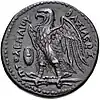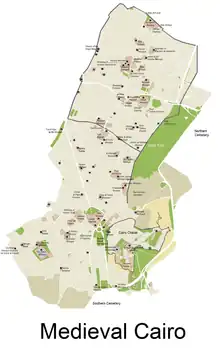| Funerary complex of Sultan al-Ashraf Qaytbay | |
|---|---|
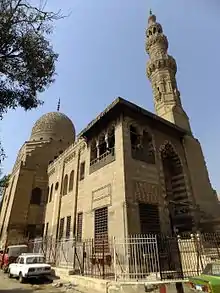 Sultan Qaytbay's mosque and mausoleum complex | |
| Religion | |
| Affiliation | Islam |
| Patron | Sultan al-Ashraf Abu al-Nasr Qaytbay |
| Location | |
| Location | Northern Cemetery, Cairo, Egypt |
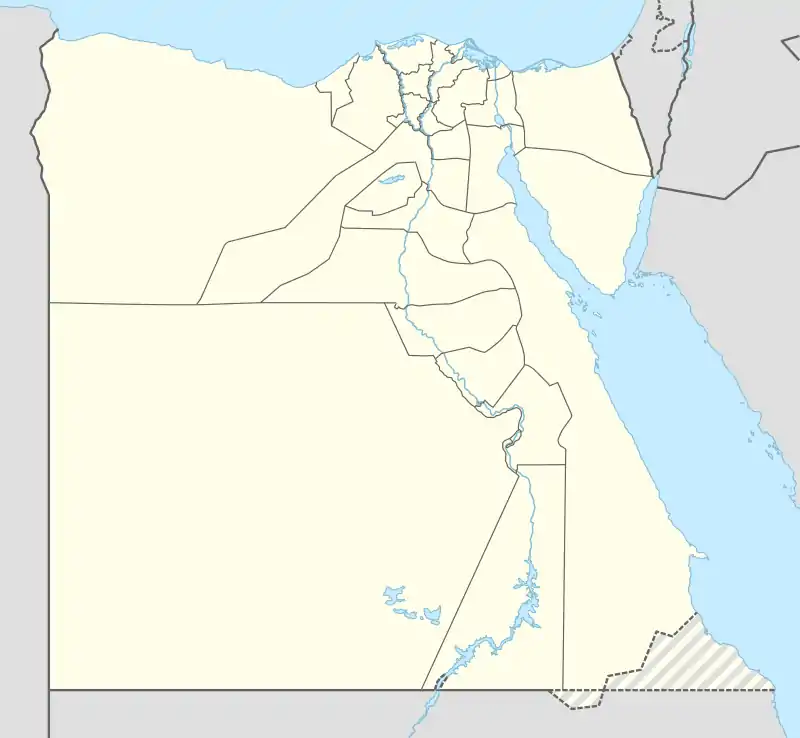 Location in Egypt | |
| Geographic coordinates | 30°02′38″N 31°16′30″E / 30.0439°N 31.2749°E |
| Architecture | |
| Type | madrasa/mosque, mausoleum, sabil, kuttab |
| Style | late Mamluk |
| Completed | 1474 |
| Specifications | |
| Dome(s) | 2 |
| Minaret(s) | 1 |
The funerary complex of Sultan Qaytbay is an architectural complex built by Sultan al-Ashraf Qaytbay in Cairo's Northern Cemetery, completed in 1474. It is often considered one of the most beautiful and accomplished monuments of late Egyptian Mamluk architecture, and is pictured on the Egyptian one pound note.[1]: 244 [2]: 273–278 [3]: 136
Historical background
Sultan Qaytbay and his reign

Al-Ashraf Qaytbay was a mamluk purchased by Sultan Barsbay (r. 1422–1438) and served under several Mamluk sultans, the last of whom – Sultan al-Zahir Timurbugha (r. 1467–1468) – appointed him amir al-kabir, the commander-in-chief or highest position for an amir under the sultan.[1]: 246 [2]: 273 [3]: 135 Qaytbay succeeded Timurbugha as sultan at the age of 54, and ruled for nearly 29 years from 1468 to 1496, the second-longest reign of any Egyptian Mamluk sultan (after al-Nasir Muhammad). His period was marked by external threats and internal rebellions, notably from the rising Ottomans, which required costly military expeditions, as well as by financial problems.[1]: 246 [2]: 273 Nonetheless, he is also known as an effective ruler who brought long-term stability while in power. He is notable as one of the greatest patrons of architecture in the Mamluk period, particularly of the Burji Mamluk period which was otherwise marked by Egypt's relative decline.[4] He is known for at least 85 structures which he built or restored in Egypt, Syria, Palestine, and Mecca, including 17 in Cairo, and this period is characterized by a refinement of the Mamluk architectural style which included greater decorative detail.[1]: 246
Construction and context
%252C_by_Francis_Frith.jpg.webp)
Qaytbay's funerary complex was one of his earliest architectural commissions; construction work for the complex began in 1470 and the mausoleum was completed in 1474.[2]: 275 The construction period was long by Mamluk standards; however, Qaytbay's complex was on a large scale and constituted an entire royal quarter or walled suburb in the then-lightly urbanized desert cemetery area east of Cairo – now known as the Northern Cemetery.[2]: 275 This desert area was developed by the Burji Mamluks in the 15th century as the main southern Qarafa necropolis, not to mention the main city itself, became too full for major new monuments. Major construction projects like Qaytbay's may have been aimed in part at urbanizing this spacious area at the time, though eventually it became mostly an extension of the city's vast cemeteries.[5] Its religious and commercial establishments took advantage of a caravan route which ran through it from Cairo to Mecca in the east and to Syria in the north.[1]: 233 Qaytbay's large complex, like others built by Mamluk amirs and sultans, combined various charitable and commercial functions, which might have contributed to his family's financial future after his death.[1]: 246 [2]
Qaytbay's mausoleum and complex was also built close to the shrine of the Muslim mystic 'Abd Allah al-Manafi, over whose tomb Qaytbay built a new dome in 1474.[1]: 244 This may have influenced his decision to appoint a shaykh of the Maliki madhhab to his mosque, which was unusual for Mamluk institutions.[2]: 275
Description
Overview

Qaytbay's complex contained numerous buildings over a relatively vast area, enclosed by the same wall, of which one gate, Bab al-Gindi, still remains to the south of the mausoleum.[1]: 246 Many of the original structures which once faced each other on both sides of the existing street have vanished.[2]: 275 What remains today is the mosque, which is attached to the mausoleum of Qaytbay himself, as well as a maq'ad (loggia), a smaller mosque and mausoleum for Qaytbay's sons, a hod (drinking trough for animals), and a rab' (an apartment complex where tenants paid rent). At one point it was also described to have had large gardens.[2]: 275
The mosque/madrasa
The mosque (originally a madrasa), along with the mausoleum of the sultan, forms the main building of the complex and is considered exceptional for its refined proportions and the subdued yet exquisite decorations.[1]: 244–246 [2]: 276 The mosque's entrance faces north and diverts the main road slightly eastwards around the walls of the mausoleum, possibly to enhance its visual effect.[2]: 276 The façade features ablaq stonework (alternating dark and light stone) and the entrance portal is enhanced by a high elaborate groin-vaulted recess with muqarnas squinches. The minaret stands above the entrance on the western side and is exquisitely carved in stone, divided into three stories with elaborately carved balconies. The eastern corner of the façade is occupied by a sabil (from which water could be dispensed to passers-by) on the ground floor and by a kuttab (school) on the top floor. The former is marked by large windows with iron grilles, while the later is marked by a loggia with open arches on two sides.
Inside, the vestibule features another ornate groin-vault ceiling and leads to the main sanctuary hall which follows a modified layout of the classic madrasa, with two large iwans on the qibla axis and two shallow or reduced iwans to the sides.[1]: 245 The hall is richly decorated in stone-carving, painted wooden ceilings and coloured windows. The mihrab is relatively modest but the wooden minbar is richly carved with geometric patterns and inlaid with ivory and mother-of-pearl.[6] The wooden lantern ceiling above the central space is notable for its carving and painted pattern but is a restoration work by the "Comité" and not the original.[2]: 276 The central floor also features elaborate polychrome patterned marble but is usually covered by carpets.[6]
- The mosque/madrasa
.jpg.webp)
.jpg.webp) The entrance portal
The entrance portal.jpg.webp) Details of the minaret
Details of the minaret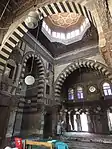
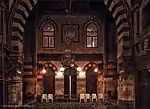 The western iwan
The western iwan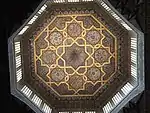 The wooden lantern ceiling over the prayer hall of the mosque
The wooden lantern ceiling over the prayer hall of the mosque
The mausoleum and dome
Qaytbay's mausoleum projects from the eastern side of the building, which makes the dome more visible from the street and allows for more light to reach the interior through the northern-facing windows. The outer dome of the mausoleum demonstrates an evolution from the stone domes built earlier and nearby by Sultan Barsbay and others: it is often cited as the apogee of Mamluk dome design in Cairo due to its complex stone-carved decorative pattern.[1]: 245 [7]: 88–89 This pattern features a central geometric star radiating from the apex of the dome and an arabesque floral design which are superimposed and enhanced by natural shadows.[2]: 276
On the inside, the mausoleum chamber is reached from a door next to the qibla wall. It is decorated with a carved and ablaq mihrab, polychrome marble paneling, and a high dome with muqarnas pendentives.[1][2] It contains the sultan's tomb as well as an alleged footprint of the Prophet Muhammad brought from Mecca.[8]
- The mausoleum
_DSCF0095.jpg.webp) The dome of the mausoleum
The dome of the mausoleum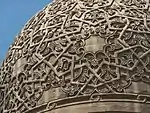 Closeup of the dome's stone-carved relief patterns
Closeup of the dome's stone-carved relief patterns.jpg.webp) The mausoleum chamber of Sultan Qaytbay, with mihrab visible (photo from 2006, before recent restorations)
The mausoleum chamber of Sultan Qaytbay, with mihrab visible (photo from 2006, before recent restorations).jpg.webp) Interior of the mausoleum dome
Interior of the mausoleum dome
Auxiliary structures
To the west of Qaytbay's main mosque is a smaller domed tomb which may have been built earlier when Qaytbay was only an amir, but was later dedicated to his sons.[2]: 277 It was later used by a Turkish Sufi named Gulshani during the Ottoman period.[1]: 245 The small dome is decorated on the outside in a stone-carved pattern similar to that of the sultan's mausoleum but slightly simpler.[2]: 277 The tomb is attached to a building which seems to have been part of the royal residential complex which Qaytbay built.[9] Just west of this is a maq'ad, which usually denotes a loggia overlooking a courtyard but in this case is an enclosed hall with many windows, located over storage rooms.[1]: 246
Just to the north of the mosque, on the main street, is a hod or drinking trough for animals, with shallow decorative niches along its wall.[1]: 244 Further north are the semi-ruined remains of a rab' or apartment complex on the west side of the main street. It is partially buried below street level but its high vaulted entrance portal is still visible.[2]: 276
- Auxiliary structures of the complex
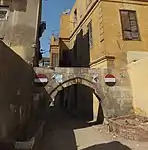 The remains of the old gate of Qaytbay's complex, Bab al-Gindi
The remains of the old gate of Qaytbay's complex, Bab al-Gindi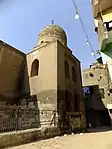 The smaller attached mausoleum, dedicated to Qaytbay's son and, later, to Gulshani
The smaller attached mausoleum, dedicated to Qaytbay's son and, later, to Gulshani The (recently restored) maq'ad of Qaytbay's complex, a part of the residential compound he built
The (recently restored) maq'ad of Qaytbay's complex, a part of the residential compound he built The hod of Qaytbay complex, a drinking trough for animals (pictured in 2012, before recent restoration)
The hod of Qaytbay complex, a drinking trough for animals (pictured in 2012, before recent restoration)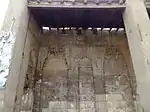 Stone-carved details of the hod
Stone-carved details of the hod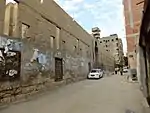 The remains of the rab' or apartment bloc of Qaytbay's complex, north of the mosque
The remains of the rab' or apartment bloc of Qaytbay's complex, north of the mosque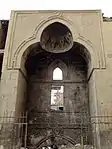 Portal of the rab' of Qaytbay's complex
Portal of the rab' of Qaytbay's complex
Modern-day use and restoration
For the past few years, the Cairo-based ARCHiNOS Architecture has been conserving monuments within the funerary complex of Sultan al-Ashraf Qaitbey. The work is primarily financed by the European Union and done under the auspices of the Historic Cairo Project within the Egyptian Ministry of Antiquities. ARCHiNOS has increasingly included social development and cultural components in its work, and has adapted the reception hall in the Sultan's onetime residence (maq‘ad) for a hub of art and culture in the neighbourhood. ARCHiNOS also upgraded the small urban square in front of the building to make it a fitting setting for various cultural events organised in and around the maq‘ad of Sultan Qaitbey. In 2016, the not-for-profit Sultan Foundation has been established to provide access to culture in the underprivileged neighbourhood and to promote links between preservation of cultural heritage and social and economic development.[10][11]
See also
References
- 1 2 3 4 5 6 7 8 9 10 11 12 13 14 15 Williams, Caroline. 2008 (6th ed.). Islamic Monuments in Cairo: The Practical Guide. Cairo: American University in Cairo Press.
- 1 2 3 4 5 6 7 8 9 10 11 12 13 14 15 16 17 Behrens-Abouseif, Doris. 2007. Cairo of the Mamluks: A History of Architecture and its Culture. Cairo: The American University in Cairo Press.
- 1 2 AlSayyad, Nezar. 2011. Cairo: Histories of a City. The Belknap Press of Harvard University Press.
- ↑ Raymond, André (2000) [1993]. Cairo. Translated by Wood, Willard. Harvard University Press. pp. 165–188. ISBN 978-0-674-00316-3.
- ↑ El Kadi, Galila; Bonnamy, Alain (2007). Architecture for the Dead: Cairo's Medieval Necropolis. Cairo: The American University in Cairo Press.
- 1 2 Discover Islamic Art (entry on "Madrasa and Mosque of Sultan Qaytbay"), retrieved on January 25, 2014, http://www.discoverislamicart.org/database_item.php?id=monument;ISL;eg;Mon01;12;en
- ↑ O'Neill, Zora et al. 2012 (11th edition). Lonely Planet: Egypt. Lonely Planet Publications.
- ↑ McGregor, Richard J. A. (2020). Islam and the Devotional Object. Cambridge University Press. pp. 140–141. ISBN 9781108483841.
- ↑ Williams, Caroline (2018). Islamic Monuments in Cairo: The Practical Guide (7th ed.). Cairo: The American University in Cairo Press.
- ↑ ARCHiNOS Architecture website, retrieved November 2018, https://www.archinos.com
- ↑ The European Union Delegation to Egypt, Culture Heritage for the Living in the City of the Dead, retrieved December 2018, https://eeas.europa.eu/delegations/egypt/42730/culture-heritage-living-city-dead_en
External links
- 3D Virtual Tours - spherical view of the interior of Qaytbay's mosque.
- 3D Virtual Tours - spherical view of the interior of Qaytbay's tomb chamber.
- Discover Islamic Art - information and pictures on Qaytbay's mosque/madrasa, including floor plan.
- Dobrowolska Agnieszka/Dobrowolski, Jaroslaw: More than Stones: Heritage for the Living in Cairo's 'City of the Dead', 2018

